Monkeys are fascinating creatures that come in all shapes and sizes. While some monkeys can grow to be quite large, others are incredibly small.
In this article, we will be exploring the top 10 smallest monkeys in the world. As most monkeys are arboreal and adapted to move swiftly through the trees, most of them are small in size, at least when compared to apes such as chimps and gorillas or ground-dwelling monkeys such as baboons.
You are reading: Top 10 Smallest Monkeys In The World
The length of these monkeys describes the distance from the nose to the root of the tail. In some of these monkeys, their tail is considerably longer than their body and often prehensile. The top 9 smallest monkeys in the world can all be found in South America, while the 10th smallest on our list, the Talapoin Monkey, lives in Africa.
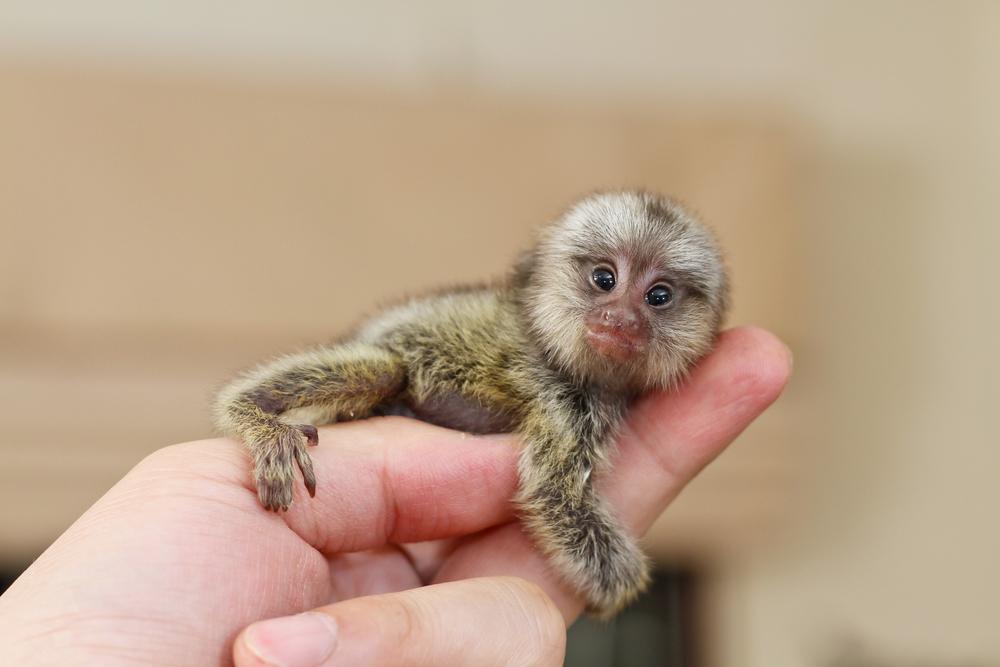
Top 10 Smallest Monkeys In The World
Pygmy Marmoset
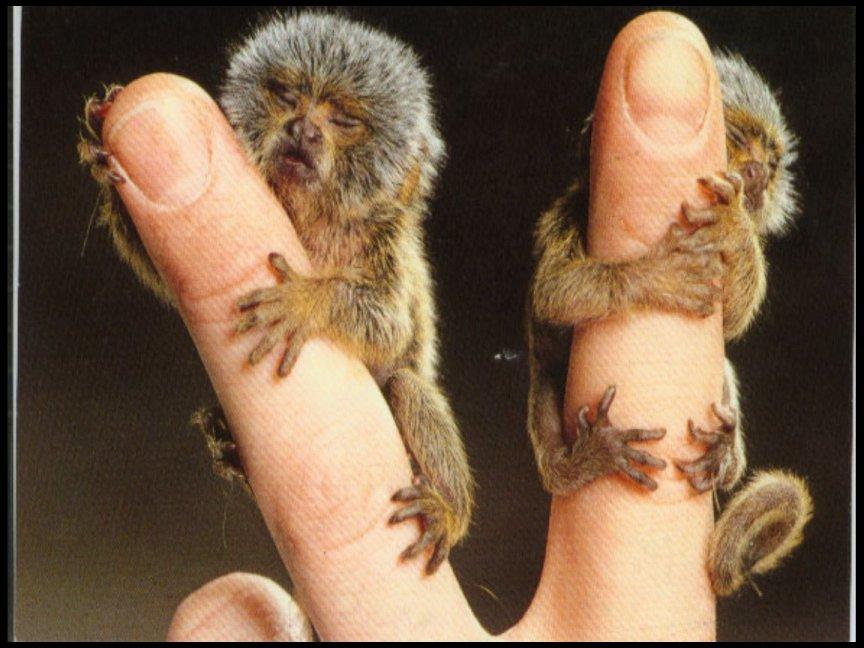
The Pygmy Marmoset, also known as the finger monkey, is the smallest monkey in the world. It belongs to the Callitrichidae family and is native to the rainforests of the western Amazon Basin in South America.
The body of an adult Pygmy Marmoset measures about 4 to 6 inches long, and its squirrel-like tail is 6 to 9 inches long. They are highly social primates and gather into stable groups of 2-15 marmosets, which are normally family troops consisting of a breeding pair and their young.
Pygmy Marmosets are arboreal and diurnal animals, active during cooler mornings and late afternoons. They are herbivorous (frugivorous, gumivorous, nectarivorous, folivorous) and carnivorous (insectivorous) animals, feeding upon a wide variety of food such as nectar, fruit, leaves, and insects.
Due to their choice of diet, Pygmy Marmosets may impact the health of their habitat. The Pygmy Marmoset is classified as Vulnerable (VU) by the International Union for Conservation of Nature (IUCN) due to habitat loss and the pet trade.
Silvery Marmoset
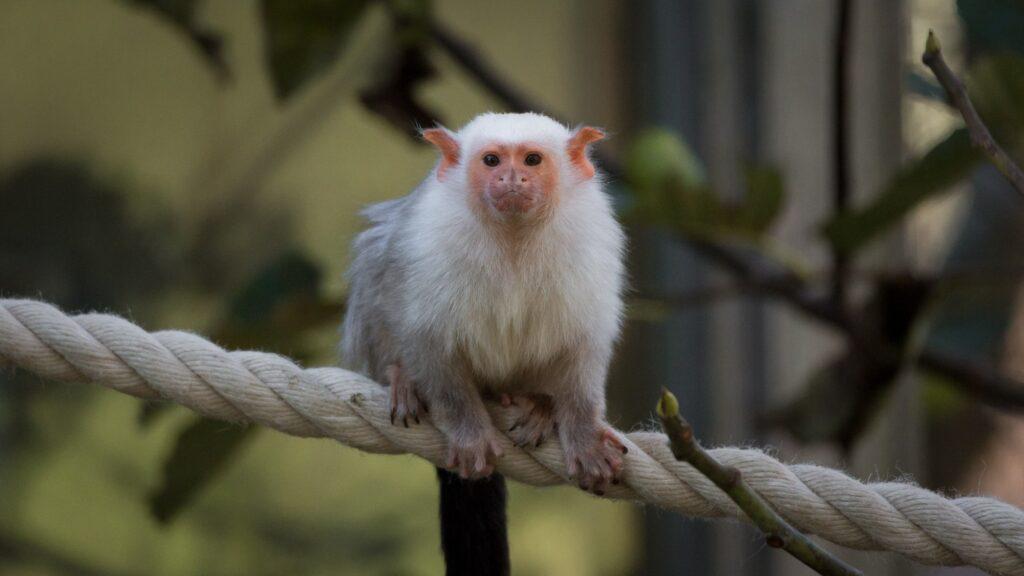
The Silvery Marmoset (Mico argentatus) is a New World monkey that lives in the eastern Amazon Rainforest in Brazil. They are also known as the White-tufted-ear Marmoset.
The fur of the Silvery Marmoset is colored whitish silver-grey except for a dark tail. They reach a size of 18 to 28 cm (7.1 to 11.0 in) and weigh from 300 to 400 g (11 to 14 oz).
Silvery Marmosets are arboreal and diurnal, using their claws to climb trees. They spend the night in tree hollows or in very close vegetation. They live together in small groups and mark their territory with scent glands, driving out intruders by shouting or by facial expressions (lowered brows and guarded lips).
Silvery Marmosets are omnivorous, feeding on fruits, insects, and small animals. Studies show that they prefer secondary growth forests and edge growth forests due to some of the benefits that the habitat presents such as an abundance of insect prey and dense vegetation.
The IUCN Red List classifies Silvery Marmosets as Least Concern (LC) due to their wide distribution and adaptability to different habitats.
Cotton-top Tamarin
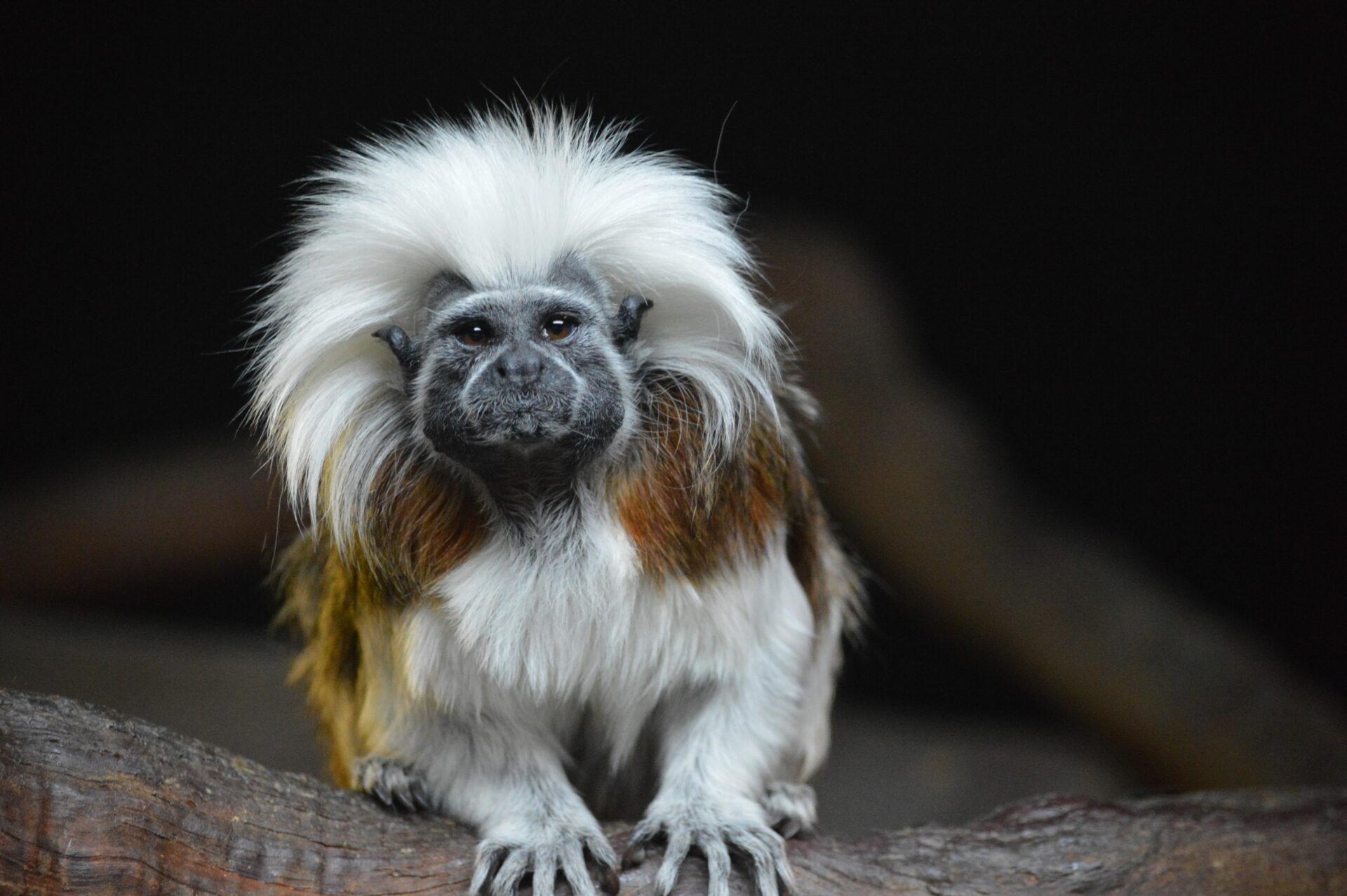
The Cotton-top Tamarin (Saguinus oedipus) is a small New World monkey that is native to the lowland rainforests of Colombia.
Appearance
– The Cotton-top Tamarin has a characteristic white crest that is composed of long hairs, surrounding its neck.
– It exhibits a rather small body and a thick coat, which is brown on the back and shoulders.
– The head crest and legs vary in color from white to yellow.
Behavior
– Cotton-top Tamarins are very social primates, forming troops of up to 19 individuals with 3-9 on average.
– Groups form a clear dominance hierarchy where only dominant pairs breed.
– The female normally gives birth to twins and uses pheromones to prevent other females in the group from breeding.
– Cotton-top Tamarins have been extensively studied for their high level of cooperative care, as well as altruistic and spiteful behaviors.
Habitat and Conservation
– Cotton-top Tamarins are found only in northwestern Colombia, where their tropical rainforest habitat is being destroyed at an alarming rate.
– The IUCN Red List classifies Cotton-top Tamarins as Critically Endangered (CR) due to habitat loss and the pet trade.
– The Wildlife Conservation Network has launched a program to help protect Cotton-top Tamarins in Colombia, which includes purchasing tití-posts made of recycled plastic to reduce dependence on wooden posts for fences and outfitting field assistants with research gear.
Golden Lion Tamarin
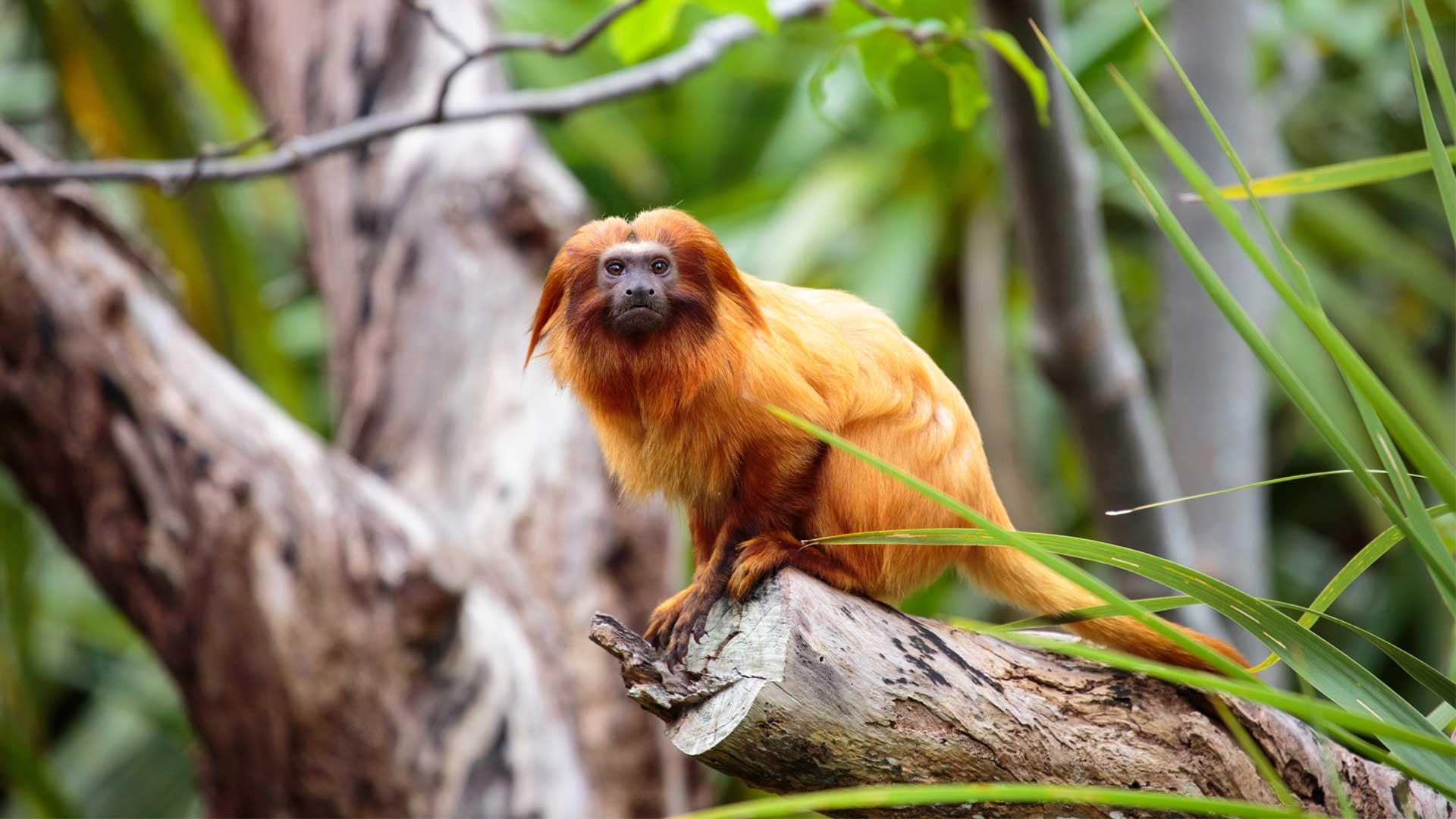
The Golden Lion Tamarin (Leontopithecus rosalia) is a small New World monkey that is native to the Atlantic coastal forests of Brazil.
Appearance
– The Golden Lion Tamarin is named after its bright reddish-orange pelage and the extra-long hairs around the face and ears that give it a distinctive mane.
– Its face is dark and hairless, and its bright orange fur does not contain carotenoids, which commonly produce bright orange colors in nature.
– The Golden Lion Tamarin is the largest of the callitrichines, typically measuring around 261 mm (10.3 in) and weighing around 620 g (1.37 lb).
Behavior
– Golden Lion Tamarins are social primates, forming groups of 2-8 members.
– These groups usually consist of one breeding adult male and female but may also have 2–3 males and one female or the reverse.
– Golden Lion Tamarins are omnivorous, feeding on fruits, insects, and small invertebrates.
– They use their long, slender fingers and hands to probe into crevices, bark, bromeliads, and other hiding places for their prey.
Habitat and Conservation
Read more : Discover The Top 5 Largest, Most Dangerous Spiders In Nevada
– The Golden Lion Tamarin is an endangered species, with habitat loss being the primary threat to its survival.
– The Smithsonian’s National Zoo has made a major commitment to the captive breeding and conservation of Golden Lion Tamarins.
– The Save the Golden Lion Tamarin organization is also working to protect and conserve this species in the wild.
Common Marmoset
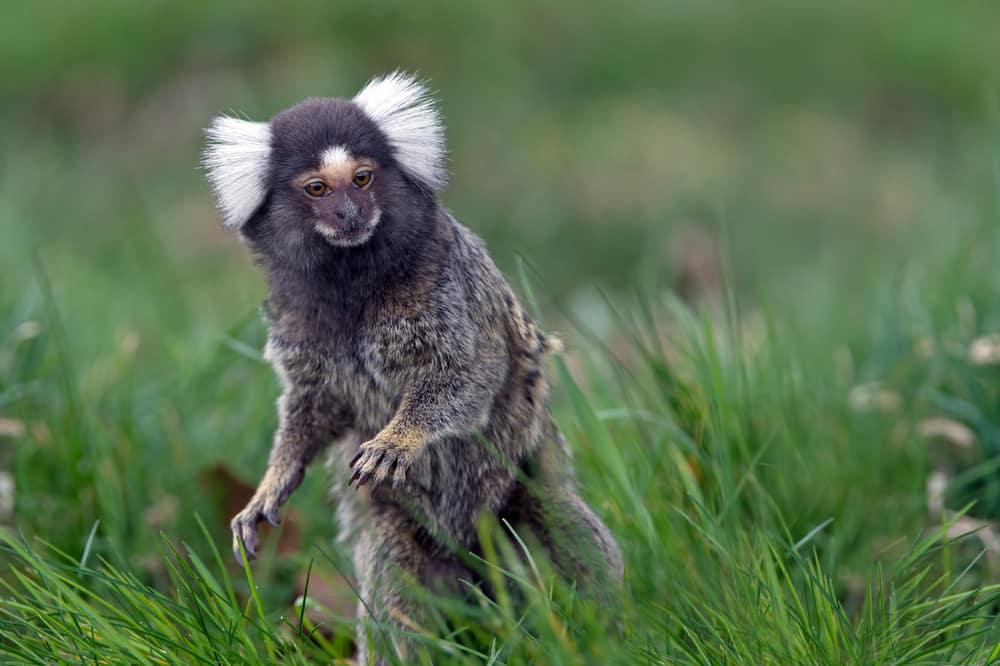
The Common Marmoset (Callithrix jacchus) is a small New World monkey that is native to the northeastern coast of Brazil.
Appearance
– The Common Marmoset has a body length of about 12-15 cm, with a tail length of 29.5-35 cm.
– Distinguishing characteristics of Common Marmosets include white tufts around their ears and a black and white striped tail.
Behavior
– Common Marmosets are social primates, living in groups of up to 15 individuals.
– They are diurnal and arboreal, spending most of their time in trees.
– Common Marmosets are omnivorous, feeding on insects, fruit, and tree sap.
Habitat and Conservation
– Common Marmosets are not currently considered endangered, but their habitat is threatened by deforestation and the pet trade.
– They are often kept as pets due to their small size and cute appearance, but they require specialized care and are not suitable for most households.
– The Wisconsin National Primate Research Center provides a fact sheet on Common Marmosets, including information on their taxonomy, morphology, and ecology.
Dusky Titi
The Dusky Titi Monkey (Callicebus moloch) is a species of titi monkey, a type of New World monkey, endemic to Brazil.
Appearance
– The Dusky Titi Monkey has a rounded head and a thick, soft coat, and frequently adopts a characteristic posture with the body hunched, limbs close together, and a tail hanging down.
– The body of the Dusky Titi Monkey is 28–39 cm (11–15 in) long, and the tail is 33–49 cm (13–19 in).
Behavior
– Dusky Titi Monkeys are social primates, living in groups of up to 8 individuals.
– They are arboreal and diurnal, spending most of their time in trees.
– Dusky Titi Monkeys are omnivorous, feeding on fruits, insects, and small animals.
Habitat and Conservation
– The Dusky Titi Monkey is not currently considered endangered, but its habitat is threatened by deforestation and the pet trade.
– The yodeling of the Dusky Titi Monkey is one of the first sounds you’ll hear each morning at Rainforest Expedition’s eco-lodges.
Squirrel Monkey
Squirrel monkeys are New World monkeys of the genus Saimiri, and they are the smallest species of New World monkey.
Appearance
– Squirrel monkeys have a small body size, measuring around 25-35 cm (9.8-13.8 in) in length, with a tail that is slightly longer than their body.
– They have a short, dense fur that is usually olive-green or gray on their back and yellowish-orange on their belly.
Behavior
– Squirrel monkeys are diurnal and arboreal, spending most of their time in trees.
– They are highly social animals, living in large groups of up to 500 individuals.
– Squirrel monkeys are omnivores, eating primarily fruits and insects, but they also eat seeds, leaves, flowers, buds, nuts, and eggs.
Habitat and Conservation
– Squirrel monkeys are native to the forests and tropical jungles of Central and South America.
– The common squirrel monkey is commonly captured for the pet trade and for medical research, but it is not threatened.
– Two squirrel monkey species are endangered: the Central American squirrel monkey and the black squirrel monkey are listed as vulnerable by the IUCN.
Night Monkey
Night monkeys, also known as owl monkeys or douroucoulis, are nocturnal New World monkeys of the genus Aotus, the only member of the family Aotidae.
Appearance
– Night monkeys have large eyes that face forward, which gives them binocular vision and helps them to see in the dark.
Read more : Top 10 Most Colorful Animals In The World
– They have a short, furry tail and soft, thick fur that is usually gray or brown on their back and yellowish-orange on their belly.
Behavior
– Night monkeys are primarily active at night, although some daytime activity has also been reported.
– They are highly social animals, living in small family groups of a mated pair and their immature offspring.
– Night monkeys are omnivores, eating primarily fruits and insects, but they also eat seeds, leaves, flowers, buds, nuts, and eggs.
Habitat and Conservation
– Night monkeys are found across Panama and much of South America in primary and secondary forests, tropical rainforests, and cloud forests up to 2,400 meters (7,900 ft).
– Night monkeys are not currently considered endangered, but their habitat is threatened by deforestation and the pet trade.
– The subspecies of Azara’s night monkey, Aotus azarae, has irregular bursts of activity during day and night, making them cathemeral, rather than strictly nocturnal.
Black-capped Squirrel Monkey
The Black-capped Squirrel Monkey (Saimiri boliviensis) is a species of New World monkey native to the upper Amazon basin in Bolivia, western Brazil, and eastern Peru.
Appearance
– Black-capped Squirrel Monkeys have dense, short, yellowish-tan hair, and a dark “crown” atop their heads.
– They have a white face, and their ears, throat, head, back, and legs are yellow to olive in color.
– Infants in this species are born with a prehensile tail but lose this ability when growing.
Behavior
– Black-capped Squirrel Monkeys are arboreal and diurnal animals, spending most of their time in trees.
– They are social animals, living in groups of up to 50 individuals.
– Black-capped Squirrel Monkeys are omnivorous, feeding on fruits, insects, and leaves.
Habitat and Conservation
– Black-capped Squirrel Monkeys are primarily tree-dwelling and are found in both native and plantation forests as well as some farmed areas near running water.
– The IUCN Red List classifies Black-capped Squirrel Monkeys as Least Concern (LC) due to their wide distribution and adaptability to different habitats.
– Black-capped Squirrel Monkeys are popular in zoos around the world.
Talapoin Monkey
The Talapoin Monkey is a small Old World monkey that belongs to the genus Miopithecus. There are two species of Talapoin Monkeys: the Angolan Talapoin and the Gabon Talapoin.
Appearance
– Talapoin Monkeys are the smallest Old World monkeys, weighing less than 2 kg (4.4 pounds).
– They have a typical length of 32 to 45 cm and a weight of approximately 1.3 kg (males) and 0.8 kg (females).
– Their fur is grey-green on top and whitish on their underside, much like the vervet monkeys.
Behavior
– Talapoin Monkeys are diurnal and arboreal, preferring rainforest or mangroves near water.
– They are highly social animals, living in large groups of up to 100 individuals.
– Talapoin Monkeys are omnivorous, feeding on fruits, insects, and leaves.
Habitat and Conservation
– Talapoin Monkeys are found in central Africa, with their range extending from Cameroon and the Democratic Republic of the Congo to Angola.
– The Gabon Talapoin is a small species of African monkey native to riparian habitats in Cameroon, Equatorial Guinea, Gabon, the western Republic of the Congo, and the far western Democratic Republic of Congo.
– Talapoin Monkeys are not currently considered endangered, but their habitat is threatened by deforestation and the pet trade.
FAQS
1. What is the smallest monkey in the world?
The smallest monkey in the world is the Pygmy Marmoset, also known as the finger monkey, which measures about 4 to 6 inches long.
2. Where are the top 9 smallest monkeys in the world found?
The top 9 smallest monkeys in the world can all be found in South America.
3. What is the 10th smallest monkey in the world?
The 10th smallest monkey in the world is the Talapoin Monkey, which lives in rainforests, mangrove swamps, and plantations in Africa.
4. What do squirrel monkeys eat?
Squirrel monkeys are omnivores, eating primarily fruits and insects, but they also eat seeds, leaves, flowers, buds, nuts, and eggs.
5. Are Talapoin Monkeys endangered?
Talapoin Monkeys are not currently considered endangered, but their habitat is threatened by deforestation and the pet trade.
6. Can Pygmy Marmosets be kept as pets?
Pygmy Marmosets are often kept as pets due to their small size and cute appearance, but they require specialized care and are not suitable for most households.
7. What is the largest of the smallest monkeys?
The Golden Lion Tamarin is the largest of the smallest monkeys, typically measuring around 261 mm (10.3 in) and weighing around 620 g (1.37 lb).
Source: https://petstutorial.com
Category: Animals










